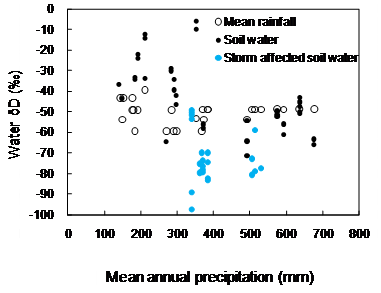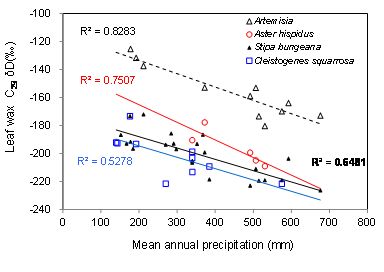The hydrogen isotopic composition (δD) of long-chain plant leaf waxes records the δD signals of source water for plant growth and is being increasingly utilized as a tool for examining past hydrological variability.
However, whether variations of leaf wax δD (δDwax) signals reflect changes of precipitation δD, precipitation amount, and/or evapo-transpiration is still unclear. This ambiguity limits our interpretation of δDwax in geological records as well as the quantitative reconstruction of paleohydrological variability.
Recently, a joint study conducted by Prof. LIU Weiguo's team from Institute of Earth Environment(IEE) of the Chinese Academy of Sciences and Prof. YANG Hong's team from Bryant University systematically investigated δD of modern precipitation, soil water and soil and plant leaf waxes in the Chinese Loess Plateau and its surrounding areas along a precipitation gradient with mean annual precipitation (MAP) varying from 140 mm to 676 mm.
The results revealed that soil water δD, soil δDwax and individual plant δDwax exhibited negative correlations with MAP, while the variation of precipitation δD showed no significant correlation with MAP.
In relatively arid areas, the δD values of soil water and plant leaf waxes were significantly more positive, suggesting that evaporation had played a crucial role in the variations of soil and plant δDwax. Therefore, δDwax preserved in paleosols could be used to infer past conditions of relative humidity in arid and semi-arid inland regions.
The results also confirmed significant δD offsets between different types of plants. Therefore, researchers suggested that vegetation changes should be constrained by independent paleobotanical data (such as pollen) before past changes of relative humidity could be quantitatively reconstructed using the δDwax proxy in arid and semi-arid inland regions.
This study, published in Chemical Geology, was supported by National Nature Science Foundation of China, the Chinese Academy of Sciences, and Bryant University summer research stipends.

Fig. 1 Changes in soil water δD and precipitation δD along the monsoon precipitation gradient (140 to 676?mm) in the Chinese Loess Plateau and its surrounding areas.(Image by LIU Weiguo, et al )

Fig. 2 Variations of plant δDwax values along the mean annual precipitation gradient in the Chinese Loess Plateau and its surrounding areas.(Image by LIU Weiguo, et al )
Contact: Bai Jie, Institute of Earth Environment, Chinese Academy of Sciences, Xi'an, China. Email: baijie@ieecas.cn
 © 2015 Institute of Earth Environment,CAS
© 2015 Institute of Earth Environment,CAS Address:No. 97 Yanxiang Road, Xi'an 710061, Shaanxi, China

 Location :
Location :